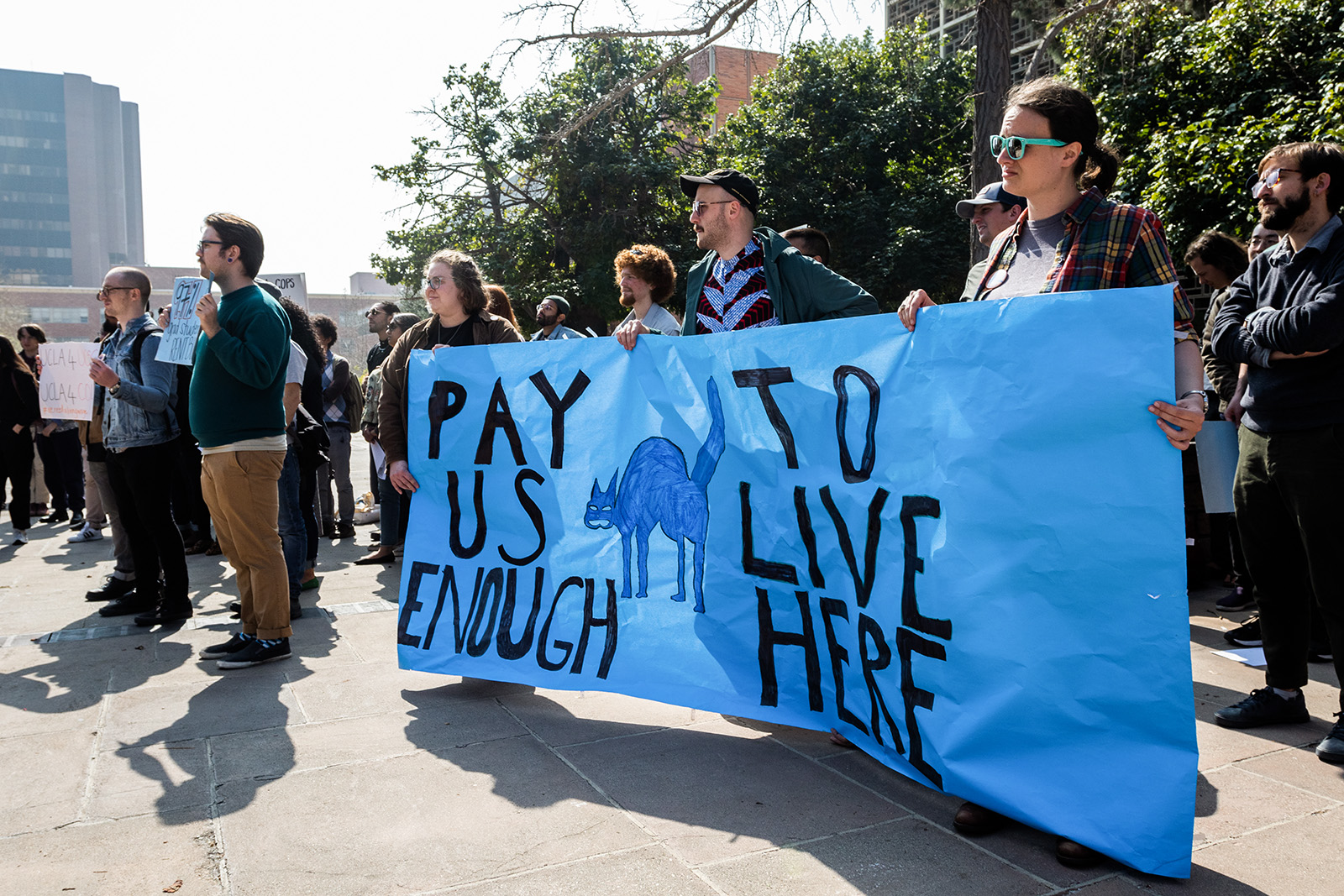The Quad: The UCSC strikes and how they’ve prompted graduate student solidarity across UC

Following a strike from graduate students at University of California, Santa Cruz, students across the UC are speaking out against a lack of affordable housing options alongside minimal compensation for their work as TAs. Some UCLA students have protested to demonstrate support. (Jintak Han/Daily Bruin senior staff)

By Rachel Sarrafzadeh
Feb. 24, 2020 12:29 p.m.
Graduate students at the University of California, Santa Cruz have had enough, and their message at the picket lines is spreading.
The UCSC students began a strike Feb. 10 after a monthslong campaign for a cost-of-living adjustment, or COLA. The problem? Grad students feel overburdened by unaffordable housing and low wages.
One of the picketers is Brenda Arjona, who, according to The New Republic, is a UCSC anthropology graduate student. She earns about $2,200 a month working part time as a teaching assistant and pays around $1,700 month for her two-bedroom university housing. She is left with $500 to cover the cost of food, medical emergencies and any other miscellaneous expenses for both herself and her 10-year-old son.
Arjona’s story exemplifies the larger housing crisis at Santa Cruz that prompted these demonstrations. The students are demanding an increase in pay of $1,412 per month to address the challenges in the particularly expensive Santa Cruz rental market.
As part of the protest, UCSC students have resolved to withhold office hours, classes and grades to mark their determination for a raise. This decision has been named a “wildcat strike,” as students are protesting without the support of United Auto Workers Local 2865, the representing union for all UC student workers.
These demonstrations have generated a great deal of tension in the community.
At least 17 people were arrested during the strike for unlawful assembly and obstructing a public roadway, according to the Santa Cruz Sentinel. Officers with helmets, batons and tear gas were seen on site, according to the Los Angeles Times.
Police intervention was not the only source of tension following the start of the strikes. UC President Janet Napolitano has denounced them, criticizing strikers Feb.14 for violating their union contracts, in addition to threatening their UC employments.
“The TAs must honor their side of the bargain, just as the University must honor its commitments. The wildcat strike must come to an end,” Napolitano wrote in her open letter to the Santa Cruz campus. Rather than a strike, Napolitano suggested developing policies to drive the construction of student housing or working with Sacramento legislators.
Although UCSC students acknowledge the gravity of these threats, their determination to spread the strike persists, as stated on the strike website.
“As long as graduate students continue to move together, we will undermine these threats, revealing them as a last-ditch scare tactic, a desperate bluff,” the letter read.
Students at UCSC are not alone in their housing struggles. A banner reading “pay us enough to live here” highlighted similar concerns at the UCLA Court of Sciences on Wednesday.
UCLA graduate students said in a Twitter thread that they have “had enough.” A “sick-out,” a day when many workers simultaneously take one of their provided sick days, was organized to stand in solidarity with UCSC and demand a cost-of-living adjustment.
As an emblem of their support, approximately 100 UCLA professors have signed a letter of nonretaliation to affirm they will not punish TAs who are participating in the strikes, as previously reported by the Daily Bruin.
Although the Santa Cruz-inspired strikes have gained a significant amount of support, this is not the first time UCLA graduate students have expressed feelings of discontentment regarding their cost of living.
In 1995, the first school-wide strike descended upon UCLA’s campus, when UCLA grad students called on the administration to address wage, workload and health care concerns.
Although it’s now years later, a similar discontentment within the UCLA community has lingered. The 2017 Student Affairs Graduate and Professional Student Survey revealed that only 12% of UCLA graduate students were very satisfied with their housing costs, 43.2% were satisfied, 31.5% were dissatisfied and 13.3% were very dissatisfied with their housing costs.
In December, the UCLA Graduate Students Association advocated for a rent cap on university housing, proposing a $1,000 limit on university housing rent to address the concerns of the nearly 45% of unsatisfied students. The bill’s $1,000 rent cap tried to relieve graduate students from using 75% to 80% of their income for rent and instead transition to a more comfortable 50%.
However, UCLA GSA President Zak Fisher told UC Santa Barbara’s Daily Nexus that administration often offers “lip service,” meaning it will acknowledge concerns in the moment but take no action for the future.
UCLA is not the only campus that has been inspired by Santa Cruz’s example. UCSC strikers have promoted other UCs to reflect on their housing conditions, recognizing a comparable need for a COLA movement.
The UC COLA movement is driven by the idea of rent burden, or when individuals spend more than 30% of income on rent. Although still in its infancy at other UC campuses, the COLA movement’s growth is noteworthy nonetheless.
At UC Davis, the UCSC strikes were used as a starting point to broaden the COLA movement to union members and undergraduate students. And at UC Berkeley, the events helped gain traction and support for Berkeley’s emerging COLA organization.
Although the combined effort across UC campuses represents a persisting struggle in the graduate community, it also illustrates a larger picture: a stand for equity across all levels of public education.
According to the Executive Board of the Council of UC Faculty Associations, dismissing the needs of graduate students interferes with both the education of undergraduates and the work of faculty.
“A thriving graduate student body is essential to our research and teaching, both at the undergraduate and graduate levels,” the board wrote in an open letter to Napolitano.


